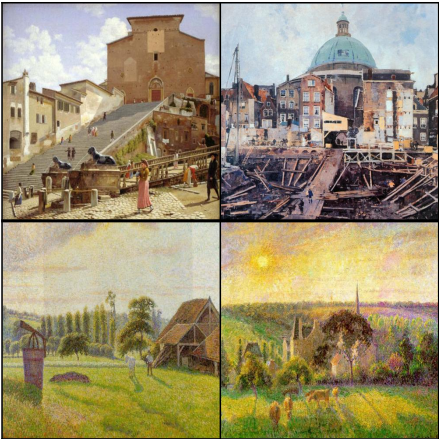From MIT's Technology Review:
The Machine Vision Algorithm Beating Art Historians at Their Own Game
Classifying a painting by artist and style is tricky for humans; spotting the links between different artists and styles is harder still. So it should be impossible for machines, right?

Few areas of academic inquiry have escaped the influence of computer science and machine learning. But one of them is the history of art. The challenge of analyzing paintings, recognizing their artists, and identifying their style and content has always been beyond the capability of even the most advanced algorithms.
That is now changing thanks to recent advances in machine learning based on approaches such as deep convolutional neural networks. In just a few years, computer scientists have created machines capable of matching and sometimes outperforming humans in all kinds of pattern recognition tasks.
Today, we see just how advanced these approaches have become in the hands of Babak Saleh and Ahmed Elgammal at Rutgers University in New Jersey. These guys have used these new machine learning techniques to train algorithms to recognize the artist and style of a fine-art painting with an accuracy that has never been achieved before.
What’s more, the results reveal connections between artists, and between entire painting styles, that art historians have labored for years to understand.
Saleh and Elgammal begin with a database of images of more than 80,000 paintings by more than a 1,000 artists spanning 15 centuries. These paintings cover 27 different styles, each with more than 1,500 examples. The researchers also classify the works by genre, such as interior, cityscape, landscape, and so on.
They then take a subset of the images and use them to train various kinds of state-of-the-art machine-learning algorithms to pick out certain features. These include general, low-level features such as the overall color, as well as more advanced features that describe the objects in the image, such as a horse and a cross. The end result is a vector-like description of each painting that contains 400 different dimensions.Previously on art experts
The researchers then test the algorithm on a set of paintings it has not yet seen. And the results are impressive. Their new approach can accurately identify the artist in over 60 percent of the paintings it sees and identify the style in 45 percent of them.
But crucially, the machine-learning approach provides an insight into the nature of fine art that is otherwise hard even for humans to develop. This comes from analyzing the paintings that the algorithm finds difficult to classify.
For example, Saleh and Elgammal say their new approach finds it hard to distinguish between works painted by Camille Pissarro and Claude Monet. But a little research on these artists quickly reveals both were active in France in the late 19th and early 20th centuries and that both attended the Académie Suisse in Paris. An expert might also know that Pissarro and Monet were good friends and shared many experiences that informed their art. So the fact that their work is similar is no surprise....MORE
Questions America Is Asking: "Art Advisors: Are They Worth It?"And on jobs and robots:
"Duveen, The Greatest Salesman in the World: Isabella Stewart Gardner, Bernard Berenson and the Boston Connection Pt. IV"
For more on the first gun for hire of the art world see the New York Review of Books "Only in America"
and The Spectator's "How honest was Bernard Berenson?"
Jobs the Robots Won't Do: Central Banker
Jobs That Robots Won't Do: Clown Shortage
A Job the Robots Won't Take: Become a Financial Charlatan
Jobs the Robots Will Do: Foreign Exchange Traders Facing Extinction as Computers Replace Humans
Robot Lobbyists Say Robots Good, Create Jobs--UPDATE
Automation Steals Jobs: Röböts Playing Motörhead